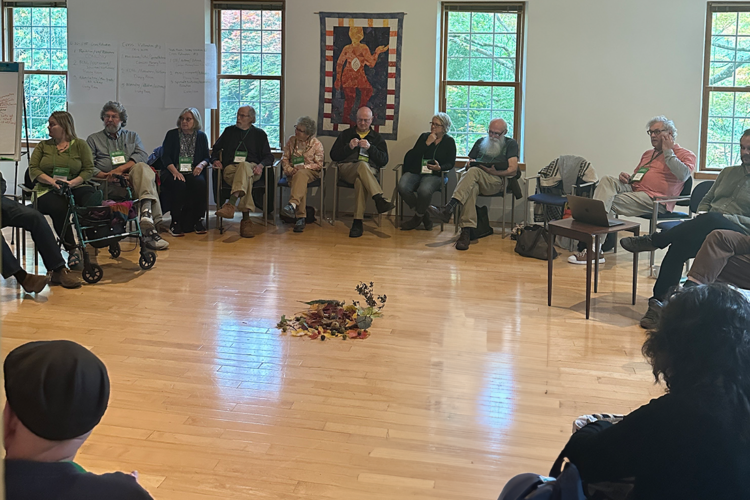Creating Campaigns: EQAT’s Process of Discernment

On March 2, 2015, PNC Bank said it would give up financing mountaintop removal coal mining. The New York Times and the Guardian joined other media outlets in announcing the outcome of EQAT’s campaign demanding that PNC “Bank Like Appalachia Matters!” (BLAM!)
The final phase of the campaign included Quakers taking coordinated action in over a dozen states from Florida to Wisconsin to Massachusetts and down the Eastern Seaboard. EQAT (pronounced “Equate”) coordinated 125 actions in the course of its five-year campaign.
In June, 2015, EQAT’s board settled on its next campaign: to challenge energy companies to take responsibility for creating jobs and benefitting poor communities by making a major shift to relying on locally generated solar power for electricity, beginning with PECO, a utility in eastern Pennsylvania.
EQAT’s discernment process, however, had already begun five months before PNC’s March announcement. The group believed that PNC, the seventh-largest bank in the U.S., was ready to change.
At first EQAT simply asked a board member to become the “point person” for conversations about the next campaign. At that point—September 2014—the organization was preparing decentralized training and organizing to raise the stakes for PNC, building upon the wide participation of Quakers and others during FGC’s Gathering in confronting PNC headquarters in Pittsburgh in July. EQAT had already organized nearly a hundred actions in the Middle Atlantic States, and now wanted to show PNC that Friends across a larger swath of the bank’s footprint were concerned enough to mount actions.
Conversations in living rooms about the next campaign led to an online discussion on EQAT-Discuss, the group’s lively dialogue venue that includes a larger geographical area. EQAT’s board then transferred the job of guiding the process to the Next Campaign Core Team, a group of volunteers assisted by EQAT’s two staff members.
EQAT members eagerly participated in a session in which the group grounded itself in its primary values, including the intersection of climate justice with economic justice. Another contextual exercise was discussing the pluses and minuses of EQAT as an action organization: its strengths, weaknesses, and areas where members wanted to develop new capacity.
Wary of a process that might become too linear and leave out the creativity that invites Spirit-led intuition, an EQAT session at Haverford College included a chaotic outburst of Post-Its with brainstormed ideas!
EQAT is aware that its organizational culture suffers from limitations imposed by the previous socialization of its members, especially race, class, and gender. Such limitations are barriers to fully discerning the divine presence. For that reason EQAT turns to external facilitators to assist the group to expand its cultural boundaries and dissolve inherited rigidities. As part of the Next Campaign process, Training for Change facilitator Erika Thorne led a large session focused on racism, which in turn led to follow-up activities including Erika coaching EQAT leadership.
A VARIETY OF ISSUES
As the spring of 2015 lengthened, individual members advocated a variety of issues for the next campaign: fracking, pipelines, freight trains carrying tar sands oil, the destruction of rainforest in Indonesia for palm oil, making the electrical grid sustainable, and others. The Core Team formalized consideration of these by encouraging subgroups to form to do research, using EQAT’s monthly general meeting as an opportunity to recruit new volunteers. Staff members were available to assist researching members.
At one of the general meetings the facilitator asked for a show of hands from those who had ever designed a campaign before from scratch. Only two raised their hands. The Core Team gave subgroups a template to support their work in the art of campaign design. The template looked like a fill-in-the-blank chart with questions to be answered in the blank spaces provided. An example of a question on the template was: which allies could be anticipated in this campaign?
Along with the template’s question was written the answer that the BLAM! campaign had given to that question, then a blank space so the subgroup could fill out the corresponding answer for their campaign proposal.
As the weeks passed, half the Core Team members joined subgroups to bolster proposals while the other half kept track of the larger process. The increased rigor supported by the template helped eliminate some of the suggested proposals. Others were dropped when the central idea failed to stir sufficient interest to do further research. Seven proposals became five, and then three. These three proposals were offered to the May general meeting where further questions were asked of the proposers.
In light of the May general meeting, two of the subgroups withdrew their proposals from consideration, leaving one remaining. Up until then over 40 EQAT members had participated in at least one face-to-face Next Campaign event, with 12-20 participating in research and formulation to varying degrees. During the spring, input increased via the email forum of EQAT-Discuss, and the Core Team reached out by phone to some Quakers and BLAM! activists to keep a channel open to EQAT supporters who live at a distance from Philadelphia.
At its May meeting the EQAT board gave the remaining proposal a kind of clearness process and decided to hold over its decision until June, to give the proposing subgroup time to respond to questions and hesitations through research, dialogue, and re-formulation, and allow for a late-starting proposal to come forward.
EQAT’s commitment to nimble, effective action allows the board to make decisions without consensus. In its June meeting, however, the board united in its intention to challenge energy corporations to create jobs and benefit poor communities by making a major shift to relying on locally generated solar power for electricity. The board stated its intention to keep jobs and racial/economic justice in the forefront of all campaign strategy.
IS THIS A RECIPE FOR OTHERS, FOR CAMPAIGN DISCERNMENT?
Not really. This process worked for a group that already had a success with a strategically designed campaign, and had been shaped by that experience. Further, the group had a pro-training culture, with ample practical experience of using external and internal expertise to unleash its creativity. The group’s confidence was supported by the experience of having been through hard and scary times together, the humility of knowing its limitations, and the inclination to research strategic questions. Finally, the group was practiced in relying on Spirit, turning to divine inspiration even in the midst of confrontation with police and handcuffs. We had no reason to doubt that way would open.
However, for groups that are new to designing a strategically effective nonviolent direct action campaign, finding a coach to support you through your first campaign is wise. The stakes are high.
Resources on EQAT Compaign
Structure & Process
For more on the structure and process of EQAT’s campaigning:, check out the following resources:
The art of choosing a goal and a target: http://wagingnonviolence.org/feature/targets-matter-small-action-group-took-mighty-bank-won/
Choices that matter—inviting non-Friends, consciously empowering members, and organizing for nimbleness: http://wagingnonviolence.org/feature/small-quaker-group-forced-pnc-bank-stop-financing-mountaintop-removal/
How training has shaped EQAT’s organizational culture: http://wagingnonviolence.org/feature/what-makes-effective-white-allies-training-not-shaming/

